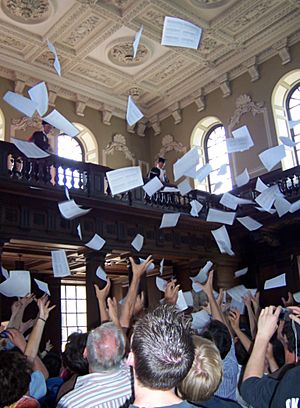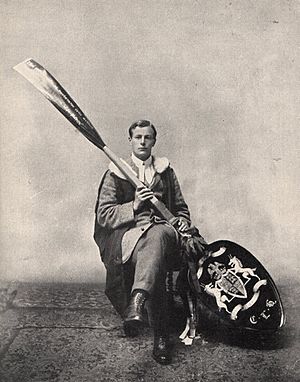Mathematical Tripos facts for kids

Results for parts II and III of the Mathematical Tripos are read out inside the Senate House, Cambridge, and then tossed from the balcony
|
|
| Type |
|
|---|---|
| Knowledge / skills tested | Mathematics |
| Duration | 3 or 4 years |
| Countries / regions | University of Cambridge |
| Languages | English language |
The Mathematical Tripos is a special mathematics course. It is taught at the University of Cambridge in England. This course is the oldest exam of its kind at the University.
Contents
How the Tripos Began
In the past, the Tripos was a unique written exam. It was for students at the University of Cambridge. Before 1824, it was called the "Senate House Examination."
From about 1780 to 1909, the "Old Tripos" was very famous. It listed students in order of how well they did. The math problems were also very hard.
For example, in 1854, the exam had 16 papers. It took 8 days to complete, totaling 44.5 hours. There were 211 questions in all. The exact scores were not shared. But in the 1860s, the top student, called the Senior Wrangler, scored 7634 out of 17,000. The lowest student to pass got 237 points. This student was given a wooden spoon. About 100 students passed with honors. Those who did not pass were called poll men.

How the Tripos Changed Math Study
The way students studied for the Tripos had a big impact. It helped shape how math was taught. It also influenced how new ideas in physics were understood. For example, it helped spread ideas about electromagnetism.
Cambridge students often memorized a lot of information. This was called "bookwork." Because of this, textbooks sometimes skipped known facts. This made it hard for people outside Cambridge to understand them.
Early History of the Exam
Over time, the Tripos changed from oral exams to written ones. The focus also shifted from Latin debates to math questions. All students had to show they were good at math.
Special teachers, called "coaches," helped students prepare. These coaches worked outside the official university classes. The exams became harder over the years. A common exam style was "bookwork" (memorized facts) plus "riders" (problems to solve).
Wranglers and Their Coaches
The list of "wranglers" became very important. These were the students who earned the highest honors.
Alexander Macfarlane explained how it worked. To get high honors, students needed a special coach. This coach was not a regular university teacher. Their job was to train students to pass the exam. Success meant solving problems quickly and writing out solutions fast.
This training was good for some skills. But it did not leave much time for deep thinking. So, the top wrangler was not always the best mathematician later in life.
William Hopkins was the first famous coach. Many of his students did very well. After he retired, Edward Routh became the main coach. Another coach, William Henry Besant, wrote a textbook. It had exercises to help students get ready for the Tripos.
Later, Robert Rumsey Webb coached many top wranglers. By the late 1800s, college teaching got better. This meant private coaches became less important. Teachers like Robert Alfred Herman then helped many top students.
Other coaches who helped students become top wranglers included E. W. Hobson and A. E. H. Love.
Sports and the Tripos
The Tripos exams were very long. They were held morning and afternoon for several days. This made them a test of endurance. Many students took up brisk walking to build their stamina.
As time went on, walking turned into other sports. Students started doing athletics, rowing, and swimming. The coaches themselves set a good example. For instance, Routh walked for two hours every day. Besant was a mountaineer, and Frost was good at many sports. By 1900, Cambridge had 23 recognized sports.
Women and the Tripos
In 1873, Sarah Woodhead was the first woman to take and pass the Mathematical Tripos.
In 1880, Charlotte Angas Scott got special permission to take the exam. Women were not usually allowed to take it. She came in eighth place among all students. But because she was a woman, a male student officially got the "eighth wrangler" title.
However, at the award ceremony, students cheered her name. Scott celebrated at Girton College. Students sang for her and crowned her with laurels. After this, women were allowed to take the exam. Their scores were listed, but separately from the men's. Women who passed got a special certificate instead of a degree.
In 1890, Philippa Fawcett became the first woman to get the top score in the Mathematical Tripos.
Changes in 1909
New rules were put in place in 1909. The math course at Cambridge still covers many topics. Exams still test problem-solving skills. But the very hardest questions are no longer encouraged.
The Modern Tripos Course
Today, the Mathematical Tripos has three years for undergraduates. These are called Parts IA, IB, and II. If a student completes these, they get a BA degree.
There is also an optional fourth year called Part III. If Cambridge students take this, they can earn a Master of Mathematics (MMath) degree. Students from other universities can also take Part III. They get a Master of Advanced Study (MASt) degree.
Students are mostly graded by written exams. These happen at the end of each school year. Some coursework is also part of the grade in the second, third, and fourth years.
Students usually attend about 12 hours of lectures each week. They also have two "supervisions." Supervisions are small group sessions. Students work through problems with a teacher or graduate student.
In the first year (Part IA), courses are mostly set. They cover basic math like algebra, analysis, and probability. The second year (Part IB) has no required courses. But some are highly recommended. These include geometry, complex analysis, and group theory. Applied courses like electromagnetism are also offered.
In Part II, students can choose from many math topics. Some courses are easier (C courses). Others are more advanced (D courses). Some students can also take a physics option in their first year. This is part of the Natural Sciences Tripos.

